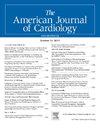Long-Term Outcomes of True Versus Nontrue Coronary Bifurcation Lesions Treated With Bioresorbable Polymer Sirolimus-Eluting Ultimaster Stent Under Intravascular Imaging Guidance
IF 2.3
3区 医学
Q2 CARDIAC & CARDIOVASCULAR SYSTEMS
引用次数: 0
Abstract
Limited evidence exists regarding the long-term outcomes of true versus nontrue coronary bifurcation lesions (CBLs) treated with current-generation drug-eluting stents and intravascular imaging guidance. The Sapporo Cardiovascular Clinic (SCVC) registry was a prospective, single-center, all-comers registry enrolling 1,727 consecutive patients treated with bioresorbable polymer sirolimus-eluting stent under complete imaging guidance. From this registry, 440 patients with CBLs (25.5%) were analyzed. Patients were categorized into the true and nontrue CBL groups according to the Medina classification (n = 234 and 206, respectively). The primary end point was the cumulative incidence of target vessel failure (TVF) (a composite of cardiac death, target vessel-related myocardial infarction, and clinically driven target vessel revascularization). The 1-stent strategy was predominantly chosen for the true and nontrue CBL groups (93.9% and 96.2%, respectively). During the median follow-up of 5.4 years, the cumulative incidence of TVF did not differ between true and nontrue CBL groups after adjustment for baseline differences (5-year incidence 22.0% vs 17.7%, adjusted hazard ratio 1.27, 95% confidence interval 0.79 to 2.05, p = 0.32). Although the Medina 0.0.1 lesions were very rare (1.1%), they had the highest rate of TVF among the Medina subtypes. Final kissing balloon inflation technique was associated with a lower incidence of TVF (p = 0.036). In conclusion, imaging-guided percutaneous coronary intervention with bioresorbable polymer sirolimus-eluting stent resulted in comparable long-term clinical outcomes between true and nontrue CBLs, primarily using the 1-stent technique.

血管内成像指导下生物可吸收聚合物西罗莫司洗脱Ultimaster支架治疗真与非真冠状动脉分叉病变的长期疗效
关于当前一代药物洗脱支架和血管内成像引导治疗真与非真冠状动脉分叉病变(CBLs)的长期结果,证据有限。SCVC(札幌心血管诊所)登记是一项前瞻性、单中心、全患者登记,纳入1,727例连续患者,在完全成像指导下接受生物可吸收聚合物西罗莫司洗脱支架(BP-SES)治疗。从该注册表中,分析了440例CBLs患者(25.5%)。根据Medina分类将患者分为真CBL组和非真CBL组(n=234和206)。主要终点是靶血管衰竭的累积发生率(TVF;心源性死亡、靶血管相关性心肌梗死和临床驱动靶血管重建术的复合。真实和非真实CBL组均主要选择单支架策略(分别为93.9%和96.2%)。在中位随访5.4年期间,在基线差异调整后,真CBL组和非真CBL组之间TVF的累积发病率没有差异(5年发病率;22.0% vs. 17.7%,校正风险比1.27[95%可信区间:0.79-2.05];P = 0.32)。虽然Medina 0.0.1病变非常罕见(1.1%),但在Medina亚型中TVF发生率最高。最后接吻气球充气技术与较低的TVF发生率相关(P=0.036)。总之,成像引导下的BP-SES PCI在真性和非真性CBLs之间的长期临床结果可比较,主要使用单支架技术。
本文章由计算机程序翻译,如有差异,请以英文原文为准。
求助全文
约1分钟内获得全文
求助全文
来源期刊

American Journal of Cardiology
医学-心血管系统
CiteScore
4.00
自引率
3.60%
发文量
698
审稿时长
33 days
期刊介绍:
Published 24 times a year, The American Journal of Cardiology® is an independent journal designed for cardiovascular disease specialists and internists with a subspecialty in cardiology throughout the world. AJC is an independent, scientific, peer-reviewed journal of original articles that focus on the practical, clinical approach to the diagnosis and treatment of cardiovascular disease. AJC has one of the fastest acceptance to publication times in Cardiology. Features report on systemic hypertension, methodology, drugs, pacing, arrhythmia, preventive cardiology, congestive heart failure, valvular heart disease, congenital heart disease, and cardiomyopathy. Also included are editorials, readers'' comments, and symposia.
 求助内容:
求助内容: 应助结果提醒方式:
应助结果提醒方式:


